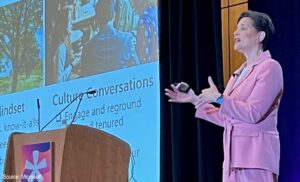Ask Lauren Gardner what it takes to build a successful inclusive hiring practice, and the Microsoft VP of global talent acquisition points to three key pillars.
Screening candidates using a skills-first mindset, building inclusion into your hiring practice and investing in human energy are the critical building blocks in establishing an inclusive hiring practice that delivers impact, said Gardner during a presentation this week at the Workhuman Live conference in San Diego.
That strategy is yielding results for Microsoft, helping to contribute to impressive diversity figures in 2022. For the first time, the software giant’s core worldwide workforce reached a composition of more than 30% women. And on top of that, more than 53% of its core U.S. workforce includes employees from racial and ethnic minority groups.
Here is how Gardner says Microsoft is making inclusion a reality:

Adopt a skills-first mindset when screening candidates
Rather than focus on candidates’ experience and whether they attended college and where, it’s far better to assess their transferable skills and demonstrated growth mindset, Gardner says.
“You need to ask, ‘What skills do you have? What can you learn? And how can we prove that out?’ ” she explains.
Taking a skills-first mindset when screening talent addresses two important considerations in the hiring process.
Related: Boese: How HR tech is responding to the new emphasis on skills
One is the rapidly changing market in which skills needed for a particular position can become obsolete within a few years, as noted by the World Economic Forum, so it’s important to find candidates with an interest in constant learning. Additionally, by focusing on skills, HR can democratize the hiring process by considering candidates who didn’t attend college or who received their job experience through other means such as teaching themselves to code versus on-the-job experience.
Build inclusive practices into your hiring strategy
Microsoft last year revamped the training it provided managers on how to conduct job interviews and opened it up to individual contributors and anyone else involved in the interview process.
“We wanted this to be part of everyone’s job, not just the hiring managers or leaders,” Gardner says. “The training focuses on identifying bias when screening, interview feedback and strategic hiring decisions.”
The software giant is also reaching out to 600 colleges with its university hiring program, a move it made during the pandemic with video interviews and continues this practice today, she says. Previously, before the pandemic, Microsoft would visit the top 20 universities by reputation ranking and miss out on a wider and more diverse pool of candidates.
Related: HR Tech Number of the Day: virtual college recruiting
Additionally, Microsoft is no longer accepting referrals for its university hiring openings.
“People refer people like themselves and that limits diversity in our candidate pool,” Gardner says. “This decision was not popular with our employees but it was the right decision to make.”
Another way Microsoft is infusing inclusiveness into its hiring practice is with its LEAP program, which offers a 16-week apprenticeship program for unconventional talent, such as neurodiverse workers. At the end of the program, the apprentice may be considered for a job at Microsoft or another company.
Invest in human energy
Currently, there is a human energy crisis, Gardner warns, and it has moved beyond burnout. For example, external forces such as global conflicts and economic uncertainty are contributing to the human energy crisis.
She pointed to six potential solutions:
- Put culture and purpose front and center
- Make wellbeing holistic
- Support career growth in meaningful ways
- Focus on leader and manager capabilities
- Be intentional to offer flexibility where possible
- Build supportive team connections
In wrapping up her presentation on inclusive hiring practices, she stressed inclusion needs to be a focus beyond the HR team and the C-suite.
“We are a global company and have a responsibility that the folks who work at Microsoft mirror everyone,” Gardner says. “There should be equal opportunity for success. Companies have a significant responsibility to democratize.”

